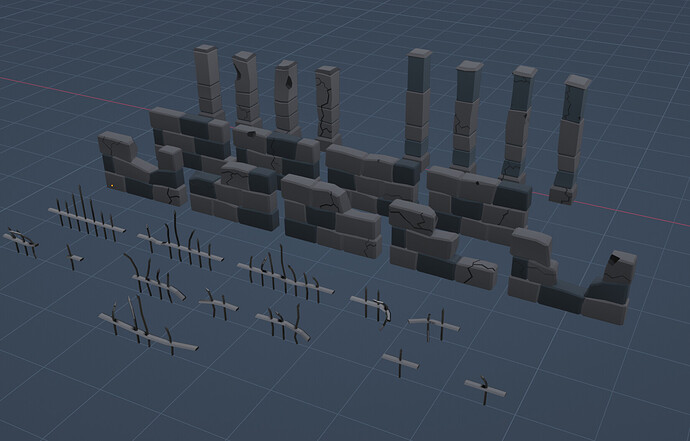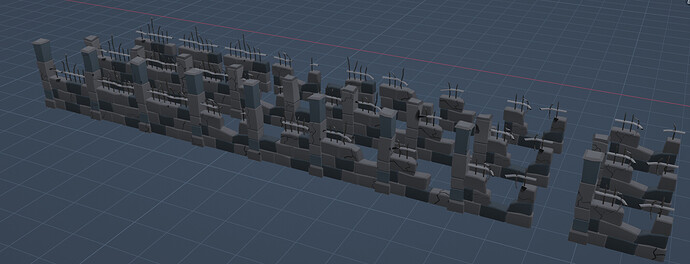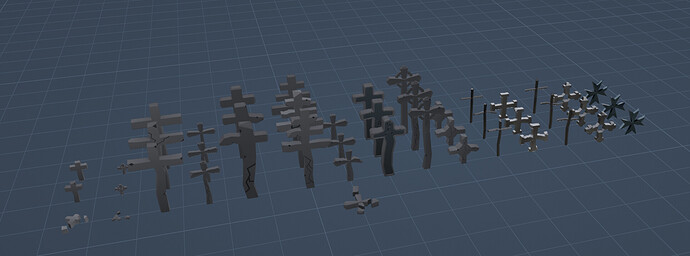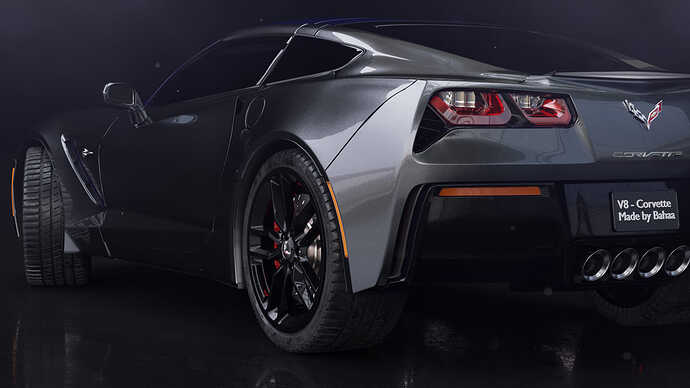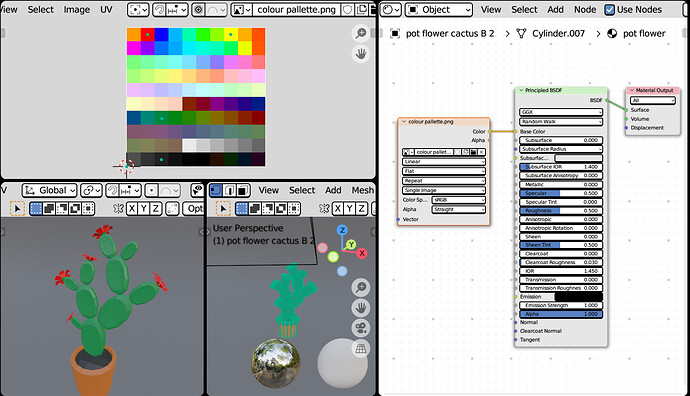Btw. for all that participated I would recommend trying to put the assets in a game engine and set up it there. A lot of times you can discover quite a lot of issues.
Good idea. Unfortunately all I know about game engine - they exist.
Because I have some questions for my potted plants. Does it matter where the origin point is? Is it possible to assemble an object from different parts in the game? If I want to make a set of different pots, is it better to make separate pots and separate plants, or make a set of all combinations of plants and pots?
Yes it does. There is no ‘universal guideline’, but if there was one it would be ‘a place that make it easy to work with’. For the plants it would probably be center of the bottom face.
Yes, of course, but there are trade offs. It all depends on the game engine and target game. Some things to consider for example are:
- draw calls (each combination of mesh+material can cause a draw call, which is expensive; but also there is batching/instancing which depending on engine and scenario might make it less of a problem) - so this would go point combining meshes
- flexibility - you make 5 pots and 5 plants and you have a lot of combinations. So maybe keeping them separate?
- ease of use - usually when level dressing you don’t want to have to assemble everything from parts (engines usually offer some kind of prefabbing system, but this is additional work that need to be done)
- customization - let’s say this is for some kind of marketplace - most people don’t want to make just ‘asset flip’ kind of games. So they want to have as much possibility of making those objects their own. One of the thing that helps in that is modularity (i.e., keeping separate parts).
etc.
it… depends again. Basically the same considerations as above (considering performance, flexibility, customization having target engine and game in mind).
This is one of the reasons why I said it’s really worthwhile experience to try it 
Thank You!
So, the best option is both versions, individual parts and a set of combinations. In fact, it’s not that difficult, in a blender you still first create individual parts, and then simply assemble them in different combinations.
I realized that I hadn’t thought about one more thing - the material. Creating a good model package for a game is a serious and extensive topic… If anyone can provide a link to a tutorial on this topic, I would be very grateful.
To some extent - yes. But at some point you hit a wall - both from user side and yours as creator. Might not be evident at first glance, but let’s say you have ‘leaves’, ‘pot’, ‘trunk’ and ‘branch’ types of objects. You model 10 of each. Now this is already overwhelming for you to manage all of it and for a user to actually figure what’s unique in the pack.
Let me give you real world example from the pack I’m making right now. “Simple thing”: a wall. It has 3 main parts: column (basically a connector), stone part, railing part. Each of them have a few variants:
Now you can make a lot of combinations out of that… Like really a lot. What I did is provided a few:
(which IMO is on the verge of being ‘too much’).
But then I thought…oh, some of those modules could have crosses on top, so I added another set:
… but I have so many crosses made already:
Should I now add all of them?  I decided against it, but keeping one variant only. I.e., to show user the idea of combining it, but not providing 100s of combinations (I could script that, both on blender and engine side, but that’s another layer of complexity that I don’t want to deal in this pack). And now you have to make also a gate(s)
I decided against it, but keeping one variant only. I.e., to show user the idea of combining it, but not providing 100s of combinations (I could script that, both on blender and engine side, but that’s another layer of complexity that I don’t want to deal in this pack). And now you have to make also a gate(s) 
… and now imagine you find a bug in one of the columns… now you have to track all of use of that column, replace it, make sure the names of object match. If you have used it in demonstration map on game engine side: check how they look after fixing (or replace objects there too if you didn’t keep names the same), etc. etc.
tl;dr: basically it’s also a balancing act between complexity (for both you and your users) and flexibility.
For low poly models use a palette texture (texture that has colors). Imphenzia has a lot of videos on this topic (and I think Grant too). Just don’t scale your UVs to 0 or sth similar (just do proper UVs, it seems like a chore at first, but when you learn how to do it efficiently, it’s not). Or you can use simple color in Blender - they should even be imported automatically with FBX files. This is another branching moment - both methods have pros and cons (e.g., if you use colors, you increase no of materials on engine side - and following that - most likely - more draw calls).
tldr (and simplification) for not low poly models is that you bake textures. Blender is not great at that.
It’s actually very hard to find good comprehensive materials about that. I think mostly because people who actually work in the industry don’t have a lot of time or incentive to do YT videos or courses. It’s kind of orthogonal skillset - and both require a lot of work and expertise. When you search for tutorials/courses always check credentials and be prepared that even experienced people will teach you something that isn’t always correct. From my side I think (this is more of overview and not blender, but transferable to it) I can recommend this course (Dekogon is art outsourcing studio, they have made a lot of assets packs for Unreal and Unity) and I know a few YT tutorials on specialized topics, like this one on texel density or this one on texturing large assets etc. For low poly stuff situation is a bit simpler and you can check Imphenzia channel for one possible workflow. He isn’t perfect and doesn’t cover all things (like lightmap UVs if you want to do stuff for Unreal), but covers the basics well.
Here’s what I came up with  (just to be clear, I’m just joking… Yes, I made this, but it took me 6 months back in 2020 to come up with it)
(just to be clear, I’m just joking… Yes, I made this, but it took me 6 months back in 2020 to come up with it)
Thank you for such a detailed answer and materials for study. 
Yes, I can now see how fast it’s going of control… Well, stopping on time is also a useful skill.
Oh… Not the level of try horror, but something very difficult to fix. (had a small flashback when at work we used a table template for different projects, and only six months later we noticed a typo. Several projects had already been submitted by that time. nothing serious, but embarrassing)
I used the color palette material from Grant Abbitt’s lessons. And… squeezed UV to a 0… 
So you are almost ready to go on material side. It kind of works in Unity (idk how well it will do with static/baked lighting, but will 100% break in Unreal for static lighting). Even if you use Imphenzia’s script to make it non-zero it will only make the warnings go away, but still will cause visual artifacts with static lighting (sometimes it’s hard to avoid them 100% even with manually made lightmap UVs, but you can avoid most of them with proper UVs). And despite dynamic lighting getting more and more popular… it will rise hardware requirements significantly for a game (static lighting is annoying and a lot of work, but still you get way better results with way smaller performance hit).
Edit: ah, if you would intend to actually sell (or even distribute the asset pack for free) just make sure that you have legal rights to that palette (if you use the one from course). The legal/tax aspects are another can of worms tbh…
Good point. Better to make my own.
@ShadowFireSage congratulations on your winning entry of the Low Poly collab. It is a good example of how a texture can increase the details of a scene. Especially when it’s low poly.
Also the use of simple objects and re-use them easily fills the scene. Good use of symmetry and sun-light.
- Joey_Cuevas - Great set, with a lot of low poly assets. I think you could improve some assets by just activating some modifiers - Add them to your asset library!
- Kzanna - I like your set - It could be the start of a geo-node module. Also, add it to your asset library!
- Willrun - Great rocket launcher! Also here, with the help of some modifiers (bevel), you can enhance the look. The image could be more centered.
- Lintari - Good low poly and re-use! But I think the composition could be improved. Maybe lowering the camera at the wheelbase. Less need for walls and grass, and add the nice sky image to fill the scene.
- Oneiropherenia - I like the colors and lighting used. The composition of the assets could be more playful. Re-use the assets to fill the scene. Like a bucket filled with books …
- BH67 - I like your story. When assets are re-used you can fill the scene more. But to be honest, I forgot that part too …
- bOBaN - Glad you’ve shared your hard work. Your low poly assets specialized for game environments, need more attention for details than only creating a mesh.
- zeRgenTa - Nothing wrong with the assets. Maybe a bit more attention to the materials, to make it more interesting (shiny metal, different (randow) wood colors).
Note: I don’t want to offend anyone. I try to write down positive ideas and visions in my simple use of the English language. I am also sometimes more inspired by a particular subject or solution. I’m also learning from you!

